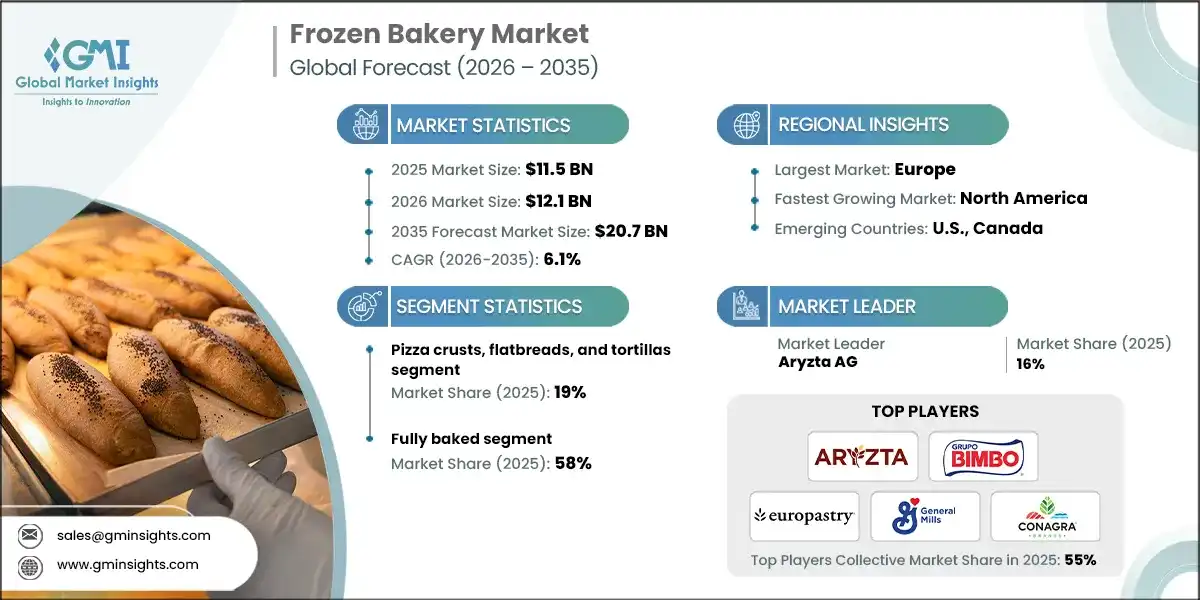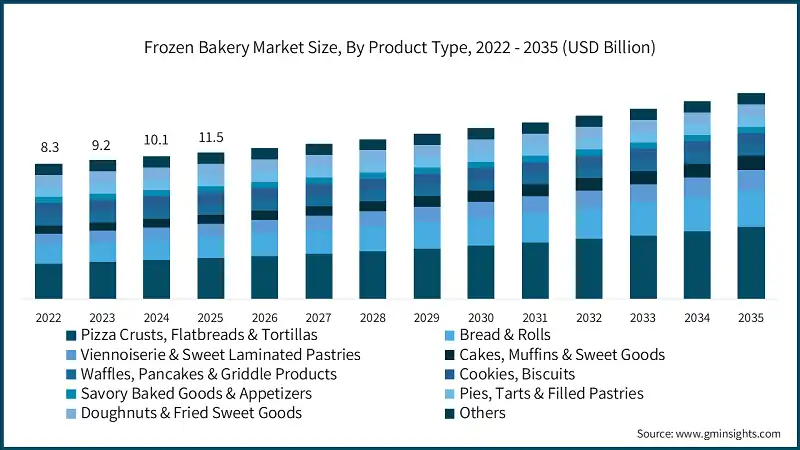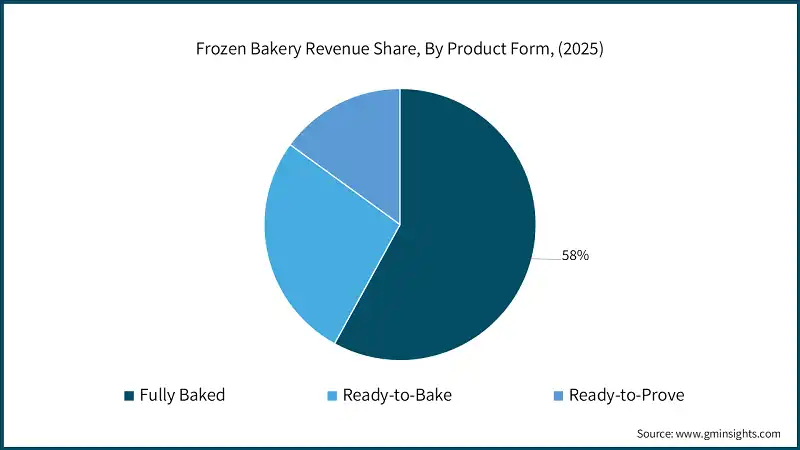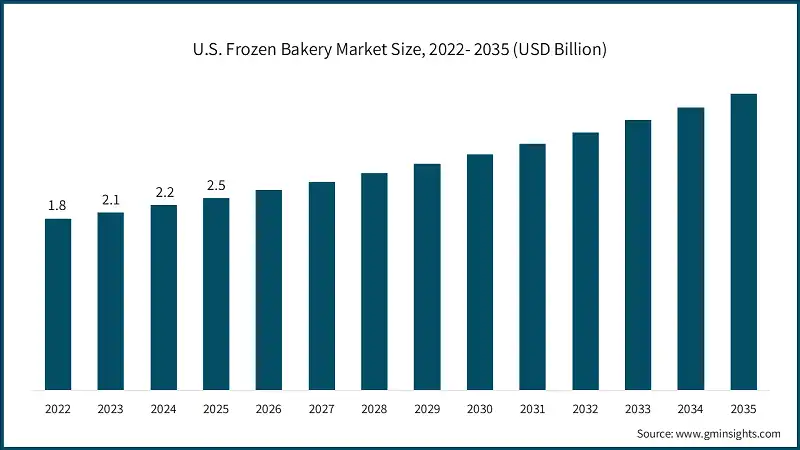Summary
Table of Content

Frozen Bakery Market
Get a free sample of this report
Thank you!
Your inquiry has been received. Our team will reach out to you with the required details via email. To ensure that you don't miss their response, kindly remember to check your spam folder as well!
Form submitted successfully!
Error submitting form. Please try again.

Request Sectional Data
Thank you!
Your inquiry has been received. Our team will reach out to you with the required details via email. To ensure that you don't miss their response, kindly remember to check your spam folder as well!
Form submitted successfully!
Error submitting form. Please try again.
Frozen bakery Market Size
The global frozen bakery market size was estimated at USD 11.5 billion in 2025. The market is projected to expand from USD 12.1 billion in 2026 to USD 20.7 billion by 2035, reflecting a 6.1% CAGR from 2026 to 2035, according to the latest report published by Global Market Insights Inc.

To get key market trends
- In the U.S., frozen baked goods retail sales reached USD 2.5 billion in 2022 and are projected to climb to USD 2.8 billion by 2027 at 2.7% CAGR through 2035, indicating steady household acceptance of frozen formats. On the manufacturing side, the FDA’s processing sector study identified 164 establishments in frozen bakery (NAICS 311813) with combined sales of about USD 1.5 billion in 2014 evidence of a sizable installed base supporting domestic supply.
- European dynamics matter greatly for the frozen bakery market. EU food and drink processing generates EUR 1,093 billion in turnover, with bakery and farinaceous products representing the largest employment share at ~34%, providing scale for both domestic consumption and export oriented production.
- Fresh bread production alone reached about EUR 40 billion in 2023, anchored by Germany, Italy, and Poland, this context underscores the breadth of the addressable base for frozen varieties and inputs. U.S. baked goods exports totaled USD 4.3 billion in 2023, with Canada and Mexico as top destinations, while the EU remained a leading global exporter with bakery products (bread, pastries, biscuits) accounting for EUR 6.4 billion in extra EU exports in 2020.
- Extended shelf life enabling longer distribution arcs, lower waste versus fresh, and labor savings for foodservice operators that need consistent quality without expanding skilled baking teams. Because of this, as cold chain infrastructure and last mile networks improve, frozen bakery becomes easier to list, ship, and store especially important in growth regions adopting modern retail. Expect the category to benefit further as new freezing technologies protect dough structure and post thaw quality, shrinking the perceived gap with fresh.
Frozen Bakery Market Report Attributes
| Key Takeaway | Details |
|---|---|
| Market Size & Growth | |
| Base Year | 2025 |
| Market Size in 2025 | USD 11.5 Billion |
| Market Size in 2026 | USD 12.1 Billion |
| Forecast Period 2026 - 2035 CAGR | 6.1% |
| Market Size in 2035 | USD 20.7 Billion |
| Key Market Trends | |
| Drivers | Impact |
| Convenience?driven lifestyle | Increase demand for ready-to-eat frozen bakery products among busy consumers. |
| Retail & online channel expansion | Enhance product accessibility and broadens customer reach through diverse sales channels. |
| Freezing technology innovations | Improve product quality, shelf life, and freshness, boosting consumer confidence. |
| Pitfalls & Challenges | Impact |
| Perception gap vs. fresh | Challenge the perception of frozen baked goods being inferior to fresh, affecting purchase decisions. |
| Opportunities: | Impact |
| Premium artisanal and clean‑label launches lift mix and pricing in developed markets . | Drive premium segment growth and higher profit margins by appealing to health-conscious and quality-seeking consumers. |
| Market Leaders (2025) | |
| Market Leaders |
16% market share |
| Top Players |
|
| Competitive Edge |
|
| Regional Insights | |
| Largest Market | Europe |
| Fastest growing market | North America |
| Emerging country | U.S., Canada |
| Future outlook |
|
What are the growth opportunities in this market?
Frozen Bakery Market Trends
- Retail e-commerce sales for baked goods in the U.S. surged at a 26.4% CAGR from 2018 to 2022 to reach USD 5.1 billion, omnichannel adoption (click and collect, same day delivery) is broadening access and frequency. Loyalty and subscription dynamics reinforce repeat purchase, 61% of delivery customers and 54% of QSR patrons view loyalty membership as important, and 62% of consumers overall 78% of Gen Z/millennials show interest in meal subscriptions. Frozen bakery fits e-commerce economics thanks to stability in transit and consistent quality on arrival. Expect packaging optimized for thermal retention and compact footprints to spread.
- Industry data shows 39% of consumers prioritize sustainability over price and 76% seek “natural” claims, with 53% examining sweeteners, signals that shape recipes and on pack messaging. Sustainable cold chains can curb food loss (about 12% tied to inadequate refrigeration) and emissions, especially as countries phase down high GWP refrigerants under Kigali. Manufacturers reformulate with whole grains, fewer additives, and natural colors/flavors while investing in lower impact refrigeration and renewable power.
- Premium brands and private label alike are raising the bar. In the U.S., Lancaster Colony’s New York brand posted the fastest CAGR among major frozen bakery brands at 3.9% from 2018 to 2022, reaching USD 294.9 million private label advanced at 3.8% CAGR. Advanced freezing (isochoric, high pressure, ultrasound and magnetic field assisted) produces smaller ice crystals and better texture retention, cutting energy 25–48% and drying times 30–70% in reported studies, which supports premium sensory outcomes. Expect ethnic flavors, artisan lamination, and better for you variants to keep widening assortments.
Frozen Bakery Market Analysis

Learn more about the key segments shaping this market
Based on product type, the frozen bakery market is segmented as pizza crusts, flatbreads & tortillas, bread & rolls, viennoiserie & sweet laminated pastries, cakes, muffins & sweet goods, waffles, pancakes & griddle products, cookies, biscuits, savory baked goods & appetizers, pies, tarts & filled pastries, doughnuts & fried sweet goods and others.
- Pizza crusts, flatbreads, and tortillas represented the largest market share at roughly 19% in 2025, helped by pizza’s universal appeal, the spread of Mexican cuisine, and the flexibility of dough bases across retail and foodservice use cases. Bread and rolls followed at about 17% market share in 2025, a reflection of staple status and the waste reduction advantage of frozen versus fresh for small outlets and operators. Viennoiserie and sweet laminated pastries accounted for about 13% market share in 2025, capturing demand for artisan style products like croissants and Danish pastries with complex lamination that benefits from centralized production.
- Cakes, muffins, and sweet goods balance celebration spikes with everyday snacking. Waffles, pancakes, and griddle items held about 10% market share in 2025, Kellogg’s Eggo alone generated USD 472.8 million in 2022 U.S. sales, showing the scale of brand loyalty in breakfast. Industry employment underscores manufacturing capacity bakeries and tortilla manufacturing employed ~350,400 workers in 2024 with projections to 369,200 by 2034.

Learn more about the key segments shaping this market
Based on product form, the frozen bakery market is segmented as fully baked, ready-to-bake, and ready-to-prove.
- Fully baked products led with roughly 58% market share in 2025, prized for “heat/serve” convenience in retail freezers and spread in QSR and institutional settings. Ready to bake (par baked/proofed) accounted for about 27% market share in 2025, enabling on premise finishing to deliver aroma and crispness while reducing labor versus scratch. Ready to prove (frozen dough) held near 15% market share in 2025, serving artisan bakeries, in store bakeries, and skilled operators wanting flexibility in shaping, sizing, and finishing.
- Lines that combine par bake precision with smarter thaw/bake guidance will gain traction in supermarkets and foodservice as staff turnover stays high. The market is expected to lean into formats that minimize skill requirements while preserving fresh baked cues.

Looking for region specific data?
The U.S. frozen bakery market valued at USD 2.5 billion in 2025 and estimated to grow to almost USD 20.7 billion by 2035. North America holds around 27% of the market share in 2025.
- The North America market is accelerating on convenience demand and off premises dining. The U.S. market also rests on a defined manufacturing base 164 establishments in NAICS 311813 posted USD 1.55 billion in sales in 2014, evidencing scale. Canada’s market advances alongside modern retail and cross border brands, while logistics constraints persist, including a chronic truck driver shortage and equipment losses cited by industry groups. Expect U.S. and Canada to deepen e-commerce penetration and premium offerings as cold chain capacity expands.
- The Europe frozen bakery market benefits by EU’s vast food processing base EUR 1,093 billion turnover with bakery and farinaceous products accounting for roughly a third of sector employment, providing depth for both domestic and export flows. Fresh bread production value reached around EUR 40 billion in 2023, with Germany, Italy, and Poland leading output, that scale supports sophisticated frozen lines and regional specialization. Regulatory frameworks shape recipes and process controls, pushing quality and compliance rigor. Because of this, the Europe frozen bakery market benefits from consumer trust in quality and safety while exporting artisan style products across regions.
- The Asia Pacific market is gaining speed as incomes rise, retail modernizes, and foodservice chains multiply. Sustainable cold chain programs from development lenders and governments are improving energy efficiency and network reliability. The China frozen bakery market and wider region benefit from westernized eating occasions, while the India market grows from a smaller base as urban consumers adopt convenience breakfast and snack formats.
- Japan and South Korea continue to innovate in frozen bread and pastry quality, and Australia’s supermarket freezers widen assortments. As cold storage and last mile improve, APAC’s share in the market should rise in both volume and value.
Frozen Bakery Market Share
The frozen bakery industry shows moderate concentration. The top five players controlled about 54.5% combined market share in 2025, led by Aryzta AG, followed by Grupo Bimbo, Europastry, General Mills, and Conagra Brands. Concentration is highest in pan regional B2B channels where a handful of suppliers manage par baked bread, viennoiserie, and dough programs for large retailers and QSR systems. On the flip side, categories like frozen breakfast and cookies feature stronger branded plays and innovation churn. Scale advantages in procurement, cold chain, and continuous bake lines allow larger incumbents to hold price/mix even as input costs fluctuate.
- Aryzta AG
- Aryzta AG anchors global leadership in 2025, operating multi region plants and serving retail, foodservice, and QSR customers with artisan breads, morning goods, and specialty items. The model prioritizes operational efficiency, customer collaboration, and innovation pipelines, supported by scale procurement and cross regional logistics .
- Aryzta AG anchors global leadership in 2025, operating multi region plants and serving retail, foodservice, and QSR customers with artisan breads, morning goods, and specialty items. The model prioritizes operational efficiency, customer collaboration, and innovation pipelines, supported by scale procurement and cross regional logistics .
- Grupo Bimbo
- Grupo Bimbo operates in 30+ countries across the Americas, Europe, Asia, and Africa, pairing fresh and frozen platforms to maximize distribution leverage and channel access. Strategic priorities brand building, innovation, and sustainability programs including renewable energy, waste reduction, and responsible sourcing, while expanding frozen portfolios for retail and foodservice.
- Grupo Bimbo operates in 30+ countries across the Americas, Europe, Asia, and Africa, pairing fresh and frozen platforms to maximize distribution leverage and channel access. Strategic priorities brand building, innovation, and sustainability programs including renewable energy, waste reduction, and responsible sourcing, while expanding frozen portfolios for retail and foodservice.
- Europastry
- Europastry specializes in frozen bread, viennoiserie, and pastries with facilities in Spain, France, the UK, Czech Republic, and the U.S., distributing globally. The company invests in R&D for lamination quality, clean label recipes, and consistent baking performance to support both B2B and retail clients.
- Europastry specializes in frozen bread, viennoiserie, and pastries with facilities in Spain, France, the UK, Czech Republic, and the U.S., distributing globally. The company invests in R&D for lamination quality, clean label recipes, and consistent baking performance to support both B2B and retail clients.
- General Mills
- General Mills participates via Pillsbury and frozen dough solutions, leveraging deep retail relationships and brand equity. The U.S. tally shows USD 272.3 million in Pillsbury frozen bakery sales in 2022, reinforcing the brand’s long standing presence in convenient baking .
- General Mills participates via Pillsbury and frozen dough solutions, leveraging deep retail relationships and brand equity. The U.S. tally shows USD 272.3 million in Pillsbury frozen bakery sales in 2022, reinforcing the brand’s long standing presence in convenient baking .
- Conagra Brands
- Conagra Brands taps a diversified frozen foods portfolio with bakery adjacencies, advantaged by retail distribution strength and analytics driven assortment optimization. Efficiency programs and brand renovation support sustained participation.
- Conagra Brands taps a diversified frozen foods portfolio with bakery adjacencies, advantaged by retail distribution strength and analytics driven assortment optimization. Efficiency programs and brand renovation support sustained participation.
Frozen Bakery Market Companies
Major players operating in the frozen bakery industry are:
- Grupo Bimbo
- Europastry
- Pan Pa Ya
- General Mills
- Rich Products Corporation
- Comapan
- Don Maiz SAS
- Vandemoortele
- Patagonia Artisan Bakers
- Aryzta AG
Frozen Bakery Industry News
- In May 2025, Edita Frozen Food Industries, one of the leading player in frozen food market announced its expansion with launch of new premium line of frozen croissants and breads. This product is tailored to meet high standards of hotels, restaurants and cafes.
- In November 2024, Wymans launched new frozen product, this new product includes protein blends for smoothies. This is company’s fourth new product launch in 4 years.
The frozen bakery market research report includes in-depth coverage of the industry, with estimates & forecast in terms of revenue (USD Billion) and volume (Kilo Tons) from 2022 to 2035, for the following segments:
Market, By Product Type
- Bread & rolls
- White bread & rolls
- Whole wheat
- Multigrain & seeded bread
- Others
- Viennoiserie & sweet laminated pastries
- Croissants
- Danish pastries
- Sweet dough rolls
- Others
- Cakes, muffins & sweet goods
- Cakes
- Muffins
- Brownies & bars
- Others
- Pies, tarts & filled pastries
- Doughnuts & fried sweet goods
- Yeast-raised doughnuts
- Cake doughnuts
- Filled doughnuts
- Others
- Waffles, pancakes & griddle products
- Savory baked goods & appetizers
- Pizza crusts, flatbreads & tortillas
- Cookies, biscuits
- Others
Market, By Product Form
- Ready-to-prove
- Ready-to-bake
- Fully baked
Market, By End Use
- Retail/consumer
- Supermarkets & hypermarkets
- Convenience stores
- Specialty food stores
- Online channels/e-commerce
- Foodservice
- Hotels, restaurants, and catering (HORECA)
- Quick-service restaurants (QSR)
- Cafeterias & institutional dining
- Artisan bakeries & in-store bakeries
- Bakery chains
- Institutional/school nutrition programs
- Others
The above information is provided for the following regions and countries:
- North America
- U.S.
- Canada
- Europe
- UK
- Germany
- France
- Italy
- Spain
- Rest of Europe
- Asia Pacific
- China
- India
- Japan
- South Korea
- Australia
- Rest of Asia Pacific
- Latin America
- Brazil
- Mexico
- Argentina
- Rest of Latin America
- Middle East & Africa
- UAE
- Saudi Arabia
- South Africa
- Rest of Middle East & Africa
Frequently Asked Question(FAQ) :
Which region held a significant share of the frozen bakery sector?
The U.S. market was valued at USD 2.5 billion in 2025 and is anticipated to cross USD 20.7 billion by 2035.
Which product category held the largest market share in 2025?
Fully baked products led the market with approximately 58% share in 2025, led by their
What was the market share of pizza crusts, flatbreads, and tortillas in 2025?
Pizza crusts, flatbreads, and tortillas accounted for roughly 19% of the market share in 2025, supported by pizza's universal appeal and the versatility of dough bases.
What is the growth outlook for ready-to-bake products?
Ready-to-bake products, including par-baked and proofed items, held about 27% of the market share in 2025.
Who are the major players in the frozen bakery industry?
Key players in the frozen bakery market include Grupo Bimbo, Europastry, Pan Pa Ya, General Mills Colombia, Rich Products Corporation, Comapan, Don Maiz SAS, Vandemoortele, Patagonia Artisan Bakers, and Aryzta AG.
What are the key trends shaping the frozen bakery market?
Key trends include rising e-commerce, sustainable cold chains, natural-ingredient reformulations, advanced freezing technologies, and growing demand for ethnic and health-focused variants.
What was the market size of the frozen bakery in 2025?
The market size was valued at USD 11.5 billion in 2025, with a projected CAGR of 6.1% from 2026 to 2035, driven by increasing consumer demand for convenience and frozen formats.
What is the expected size of the frozen bakery industry in 2026?
The market size is projected to reach USD 12.1 billion in 2026.
What is the projected value of the frozen bakery market by 2035?
The market is expected to reach USD 20.7 billion by 2035, supported by advancements in freezing technologies, sustainability initiatives, and growing e-commerce adoption.


